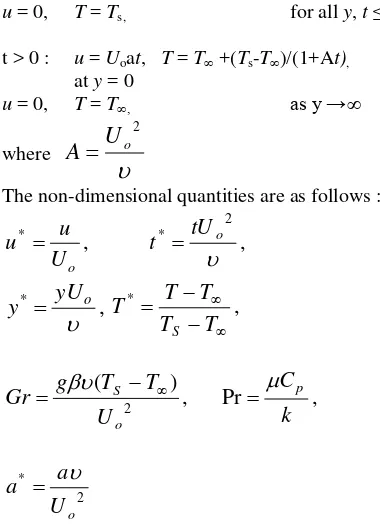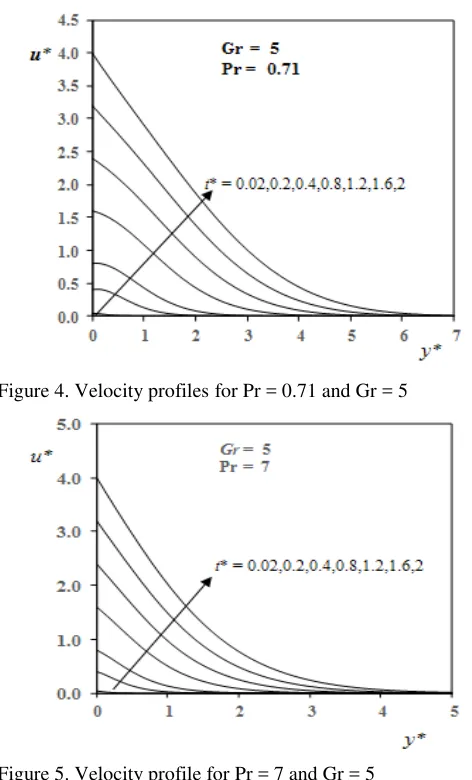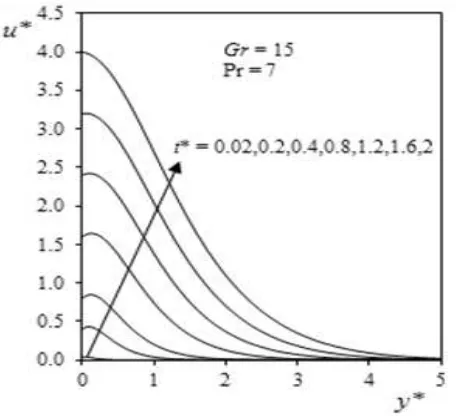International Journal of Engineering Research ISSN:2319-6890)(online),2347-5013(print) Volume No.4, Issue No.2, pp : 47 - 50 01 Feb. 2015
IJER@2015
Page 47
Analysis of Transient Natural Convection flow
past an
Accelerated Infinite
Vertical Plate
Kaprawi S.
Mechanical Engineering, Sriwijaya University
Jalan Palembang-Prabumulih km.32 Indralaya 30662, Indonesia
Corresponding E-mail : kaprawis@yahoo.com
Abstract-This work describes a vertical hot plate moves with acceleration and with variation wall temperature. The temperatures of the plate decrease with the increase of velocity of the plate. The temperature and velocity are given by the governing equations. The dimensionless equations of the problem have been solved numerically by the finite difference method. The temperature and the velocity profiles against several parameters like Prandtl Number, Grashoft number and time are presented. The results show that the temperature and velocity profiles are significantly influenced by Prandtl and Grashoft number.
Keywords - Plate, temperature, velocity, Prandtl and Grashoft number.
1 . I n t r o d u c t i o n
Study of flow with heat transfer play an important role in engineering sciences. Some important applications are cooling and heating of industrial equipment, liquid metals liquid, cooling of machine elements. The movement of equipment of thermal engines needs the cooling and heating system in order the systems run in good conditions. Some of the cooling and heating of an engineering equipment could be approached by an accelerated plate in a fluid.
An exact solution of heat transfer of fow past an exponentially accelerated infnite vertical plate with variable temperature is analyzed by Muthucumaraswamy et al. [1]. The effect of heat transfer is more in the presence of air than in water. An analytical study of an incompressible viscous fluid past an exponentially accelerated infinite vertical plate with uniform heat flux was given by Chandrakala et. al. [2].
The similar case, Muralidharan [3] gives the solution of flow past a parabolic starting motion of the infinite vertical plate with uniform heat flux and variable mass diffusion has been studied using the Laplace transform technique.
Amit et. al. [4] also studied the heat and mass transfer on flow past an exponentially accelerated infinite vertical plate with variable temperature and mass diffusion through a porous medium. The effect of heat generation on heat transfers from a vertical plate are numerically given Mamun et. al. [5]. They use the implicit finite difference method of Keller box-scheme to solve the governing equations. The linear acceleration of the plate with suction in incompressible viscous fluid was presented by Das et al. [6].
Rajesh et al. [7] studied an analytical study of the effects of temperature dependent heat sources of the free convection and mass transfer flow past an exponentially accelerated infinite vertical plate of a viscous incompressible electrically conducting fluid under the action of a uniform magnetic field through porous medium. An exact solution to the flow past an exponentially accelerated infinite vertical plate and temperature has been presented in the presence of variable mass diffusion [8,9].
The effect of rotation of the unsteady hydromagnetic flow past a uniformly accelerated infinite vertical plate in the presence of variable temperature and mass diffusion was studied by Muthucumaraswamy et al. [10]. The effect of magnetic fields on heat transfers from an accelerated plate were given by Sahin et. al [11]. The experimental study of accelerated cooling of plate is shown by Antonio et al. [12]
The literature survey show that the most of initial temperatures of accelerated platee equal to the ambient temperature. In some cases, the temperature is held constants and equals to the plate temperature for time greater than zero. The initial temperature of a vertical plate is greater than the ambient temperature. In other words, the plate is initially at high temperature or hot plate and then suddenly it moves vertically with acceleration. So there is a heat transfer of a hot plate to the ambient fluid and the plate temperature decreases with increasing time.
2. Governing Equations
The flow of a viscous incompressible fluid past an infnite vertical plate with variable temperature is considered. The plate surface temperature is initially higher than the ambient fluid around the plate and then it decreases with increasing time since the acceleration of the plate. The x-axis is taken along the plate in the vertically upward direction and the y-axis is taken normal to the plate.
At time t≤ 0, the plate is at the temperature higher than T∞ and the fluid is at rest. At time t .> 0, the plate is linearly accelerated with increasing time in its own plane and the temperature decreases with temperature T = 1/(1+at). It is assumed that the effect of viscous dissipation is negligible and by usual Boussinesq's and boundary layer approximation. The unsteady flow is governed by the following equations:
2 2
)
(
y
u
T
T
g
t
u
International Journal of Engineering Research ISSN:2319-6890)(online),2347-5013(print)
with the following initial and boundary conditions:
u = 0, T = Ts, for all y, t≤ 0.
The non-dimensional quantities are as follows :
,
After introducing the non-dimensionless quantities into the equation (1) and (3) leads to the following equations :
2
The initial and boundary conditions in non-dimensional quantities are boundary conditions are discretized with finite difference. The discretizations lead to the following equation :
2 iteration method to solve the equations. The iteration method of over-ralaxation was used in which the factor of ralaxation was chosen λ = 1.1. The calculation started by solving equation (6) until convergence was obtained and after the temperature obtained, the calculation was continued by solving equation (5) to obtain velocity of each point i,j. The absolut convergence was attained less than 10-6 and the number of iteration was about 1400 depending on the Pr and Gr number.
4. Results and Discussion
In the preceding results, the temperature and velocity are calculated for different values of Prandtl and Grashof number. In these calculations, the parameter a* = 2 is taken a constant throughout the calculation. The values of Prandtl number Pr are chosen such that they represent air (Pr = 0.71) and water (Pr = 7) since these two medias are the most used for heating and cooling process.
The temperature profiles for Pr = 0.71 are shown by Figure 2 which present variation on dimensionless temperature with distance y for some values of time t*. It is observed that temperature profile variation is significant for small t* and the variations are small for higher t*. Its is caused by the temperature at boundary condition of the plate as shown by Figure 1. The temperature gradient tends to zero at y* ≈ 6 for t* = 2 and y* ≈ 1 for small t*.
International Journal of Engineering Research ISSN:2319-6890)(online),2347-5013(print) Volume No.4, Issue No.2, pp : 47 - 50 01 Feb. 2015
IJER@2015
Page 49
Figure 2. Temperature profiles for Pr = 0.71
It is observed that all profiles decay asymptotically to zero in the free stream. Comparing figure 2 and 3. The convection current occurs in short distance from the plate. The maximum distance is y* ≈ 2 for t* = 2 where at this distance the temperature equals to the ambient temperature. The increase in Prandtl number means that the thermal diffusivity of fluid decreases. So the temperature decreases due to the decrease of thermal boundary layers.
Figure 3. Temperature profiles for Pr =7
.The effect of velocity air (Pr = 0.71) for different values of
t* and for Gr = 5 is presented in figure 4. It is observed that a rapid decrease of velocity for larger t* in the region near the plate. For t = 2, the maximum thickness of hydrodynamic
boundary layer is at about y* ≈ 6 where the velocity equals to zero. The increase in Prandtl number for constant Grashoft number leads to decrease velocity fields as it is shown by Figure 4 and 5.
Figure 4. Velocity profiles for Pr = 0.71 and Gr = 5
Figure 5. Velocity profile for Pr = 7 and Gr = 5
Figure 6 illustrate the transient velocity with higher Grashoft number Gr = 15. The thermal Grashof number signifies the relative effect of the thermal buoyancy forces to the viscous hydrodynamic force in the boundary layer flow. This gives rise to an increase in the induced flow. The velocity of the induced flow is greater than the velocity of plate.
International Journal of Engineering Research ISSN:2319-6890)(online),2347-5013(print) Volume No.4, Issue No.2, pp : 47 - 50 01 Feb. 2015
IJER@2015
Page 50
For Gr = 15 and Pr = 7, the velocity profiles are shown by Figure 6. Comparing these profiles with profiles in Figure 5, the difference is observed the fluid adjacent to the plate where the velocity is approximately equal to the velocity of the wall.
Figure 6. Velocity profile for Pr = 7 and Gr = 15. Conclusion
For higher Prandtl number, the heat transfer process occurs to the shorter distance from the plate and vice versa. In case of higher Grashoft number, the fluid velocity adjacent the plate move with high velocity which is larger than the velocity of the plate.
References
i. Muthucumaraswamy R. , K. E. Sathappany, R. Natarajan, Heat transfer effects on fow past an exponentially accelerated vertical plate with variable temperature, Theoret. Appl. Mech., Vol.35, No.4, pp. 323-331,2008.
ii. Chandrakala P. and P. Narayana Bhaskar, Effects of Heat Transfer on Flow Past an Exponentially Accelerated Vertical Plate with Uniform Heat Flux, International Journal of Dynamics of Fluids, Vol. 7, Number 1 (2011), pp. 9–16.
iii. Muralidharan M. Parabolic Started Flow Past an Infinite Vertical Plate with Uniform Heat flux and Variable Mass Diffusion, Int. Journal of Math. Analysis, Vol. 8, 2014, no. 26, 1265 – 1274.
iv. Amit, R.K.Srivastava Saraswat, Heat and Mass Transfer on Flow Past an Exponentially Accelerated Infinite Vertical Plate With Variable Temperature and Mass Diffusion Through a Porous Medium, International Association of Scientific Innovation and Research, 13-127; 2013.
v. Mamun A.A., Chowdhury Z.R., Azim M.A., Maleque M.A., Conjugate Heat Transfer for a Vertical Flat Plate with Heat Generation Effect, Nonlinear Analysis: Modelling and Control, Vol. 13, No. 2, 213–223, 2008.
vi. Das S.S., Sahoo S.K., and Dash G.C., Numerical Solution of Mass Transfer Effects on Unsteady Flow Past an
Accelerated Vertical Porous Plate with Suction, Bulletin of the Malaysian Mathematical Sciences Society, (2) 29(1), 33–42, 2006.
vii. Rajesh V.,and Varma S.V.K., Heat Source Effects On Mhd Flow Past An Exponentially Accelerated Vertical Plate With Variable Temperature Through A Porous Medium, Int. J. of Appl. Math and Mech. 6 (12): 68-78, 2010.
viii. Asogwa K.K., Uwanta I.J., Aliero A.A., Flow Past an Exponentially Accelerated Infinite Vertical Plate and Temperature with Variable Mass Diffusion, International Journal of Computer Applications (0975 – 8887) Volume 45– No.2, 2012.
ix. Girish J. Kumar, P.,Kishore M., Ramakrishna S., Mass transfer effects on mhd flows exponentially accelerated isothermal vertical plate in the presence of chemical reaction through porous media, Advances in Applied Science Research, 3 (4):2134-2140, 2012.
x. Muthucumaraswamy R.,Tina Lal and Ranganayakulu D., MHD Flow past an Accelerated Vertical Plate with Variable Heat and Mass Diffusion in the Presence of Rotation, International Journal of Innovative Research in Science, Engineering and Technology, Vol. 2, Issue 10, 2013.
xi. Sahin Ahmed and Abdul Batin, Convective Laminar Radiating Flow over an Accelerated Vertical Plate Embedded in a Porous Medium with an External Magnetic Field, International Journal of Engineering and Technology Volume 3 No. 1, January, 2013
xii. Antonio Augusto Gorni and José Herbert Dolabela da Silveira, Accelerated Cooling of Steel Plates: The Time Has, Journal of ASTM International, Vol. 5, No. 8 Paper ID JAI101777, 2008.
Nomenclature
A, a Constants
Cp Specific heat at constant pressure [J.kg -1
K-1]
Gr Thermal Grashof number
g Acceleration due to gravity [m.s-2]
k Thermal conductivity [W.m-1.K-1] Pr Prandtl number
T Temperature [K]
T Time [s]
uo Velocity of the plate [m.s-1]
y Coordinate axis normal to the plate [m] Greek symbols
β Volumetric coefficient of thermal [K-1] expansion
µ Coefficient of viscosity [Pa.s]
ν Kinematic viscosity [m2.s-1]
ρ Density of the fluid [kg.m-3] Subscripts
s surface of the plate
∞ Conditions in the free stream Superscript


